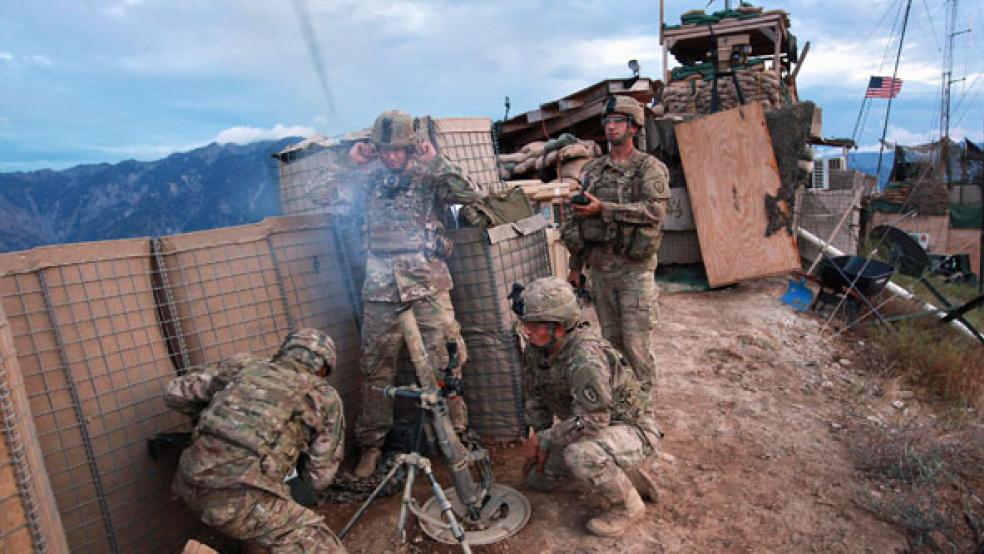The war in Afghanistan is winding down, although the nightly drumbeat of casualties on the evening news makes the U.S. military’s eventual exit seem like an ever-receding dream.
Maybe it is.
The U.S.’s top commander in that war-ravaged nation confirmed in a 60 Minutes interview broadcast Sunday that the U.S. would remain in Afghanistan beyond 2014. Marine Corps Gen. John Allen said the level of U.S. forces that will remain in the country after security responsibilities are turned over to the Afghanis has yet “to be determined.” But he confirmed it will include both advisors and soldiers engaged in counter-terrorism actions, which are costly both in terms of lives and materiel.
President Obama has promised to withdraw 33,000 of the U.S.’s 98,000 troops by the end of next summer with a goal of exiting the country by the end of 2014. But foreign policy experts and administration critics are now predicting that the U.S. will maintain a permanent garrison of anywhere from 20,000 to 30,000 troops in Afghanistan.
“The hawks in this administration and at various think tanks would like to see a presence well beyond 2014,” said Matthew Hoh, a senior fellow at the left-leaning Center for International Policy. He left the State Department in 2009 to protest the administration’s Afghanistan policy. “We’re still practicing the same policy we’ve practiced for 50 years – containment and forward presence. Only now instead of the Soviet Union, the countries we're trying to contain are Iran, Pakistan and to certain extent China.”
The pace and size of the withdrawal could have a major impact on the ongoing budget debates in Washington. The 12-member bi-partisan committee of House and Senate members – the so-called Super Committee -- has been asked to come up with $1.2 trillion in budget cuts over the next decade. The Budget Control Act (BCA) signed into law last August imposes across-the-board cuts in both domestic and military spending – so-called sequestration – if that goal isn’t reached.
of cuts in the offing, the
Pentagon and its defenders
are circling the wagons.
The BCA has already imposed about a trillion dollars in budget reductions, with two-thirds of the cuts coming from domestic programs and about one-third from the military. The estimated $350 billion in military cuts would come out of the Pentagon’s baseline budget, not the special appropriations for wars. Since the Pentagon’s total baseline budget over the next decade was slated to total $6.7 trillion, which included increases for inflation, the scheduled cuts amounted to well under 7 percent of the total.
Now, with a new round of cuts in the offing, the Pentagon and its defenders are circling the wagons. Defense Secretary Leon Panetta last week said the estimated $600 billion in new military cuts on top of the BCA cuts would be a “crazy doomsday approach” that would “hollow out the force.” Rep. Buck McKeon (R-Cal.), chairman of the House Armed Services Committee, told the Super Committee in a letter that further cuts would “break the back of our Armed Forces while slowing our economic recovery, and do little to resolve the debt crisis.”
There appears to be bi-partisan support for largely exempting the military from further cuts. Committees on Capitol Hill are already beginning to play war games with spending budgets to mitigate the impact of legislated reductions. The Senate Appropriations Committee last month moved about $10 billion in routine spending for refurbishing armored vehicles and other programs into the “overseas contingency budget” (OCO), which was $159 billion last year.
to play games, it could count
reduced military spending
in Afghanistan and Iraq.
A subcommittee of the same committee also moved $8.7 billion of State Department funding into a new OCO account. A Hill staffer for the subcommittee said that the bulk of the money is earmarked for training military and police personnel in Iraq and Afghanistan that was previously conducted by the Pentagon, and therefore justified the OCO designation.
The Congressional Budget Office’s baseline projection assumes that the $159 billion in war spending will continue for the next decade and will even increase slightly to accommodate inflation. If the Super Committee wanted to play games, experts said, it could simply consider that part of the baseline budget and count reduced military spending in Afghanistan and Iraq – the projected level for this year is about $118 billion – as part of its deficit reduction goal.
“The Super Committee is not particularly constrained,” said Gordon Adams, a professor and foreign and military policy analyst at American University. “No one knows what they will do.”
Adams pointed out that even with sequestration, a $1 trillion cut in defense spending off a nearly $7 trillion baseline would amount to the smallest post-war “build down” since the end of World War II. Build-downs after the Korean conflict, the War in Vietnam and the fall of the Soviet Union averaged about 30 percent from projected future spending levels.
That’s still twice the level of reduction that would occur if Congress cut another $600 billion from Pentagon spending over the next decade on top of the BCA. “This is not a doomsday projection,” Adams, who served at the Office of Management and Budget during the early years of the Clinton administration.
He said sequestration, the outcome of a failed Congressional process, would be management because Congress would never let it happen. Various committees would be forced to investigate and pare back unnecessary programs, not engage in across-the-board cuts.
“The Pentagon needs to differentiate between a sequester and a build-down,” he said. “Nobody would disagree that sequestering money is a stupid way to do things, even if it is announced.”





